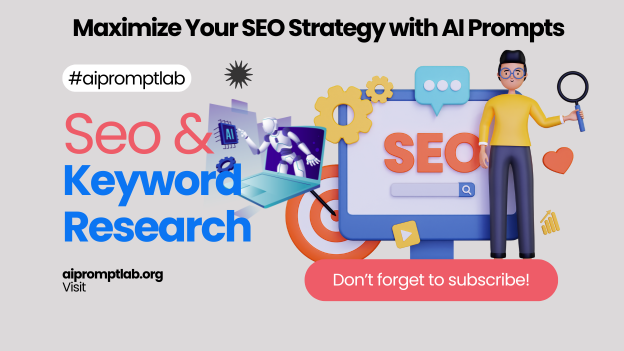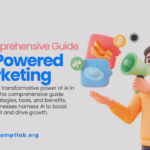
Discover the power of AI-generated content prompts to enhance your SEO strategy. Learn how to leverage AI for better content creation.
Introduction
Today, being a top-notch content provider has always been the main point. To be a high-level player, products have to be products of great workmanship. Keep it “catchy” for the audience and at the same time make it search-engine friendly. That’s where AI apps such as ChatGPT, Bing CoPilot, and Google Gemini jump into action, to perform the tasks more quickly and efficiently. Note though, that the most of this magic is the work and talent that we SEO writers put into these tools to produce a great result.
Writing the perfect SEO-driven prompt
“Prepare a detailed guide with an emphasis on ‘How to Organize Small Kitchen Spaces.’ Integrate the primary keyword ‘chic minimalist small kitchen organization’ in the introduction, headlines, and conclusion.” Cover subtopics including ‘Creative Storage Solutions,’ ‘Decluttering Strategies,’ and ‘Multipurpose Furniture Ideas,’ integrating secondary keywords ‘space-saving kitchen gadgets,’ ‘decluttering tips for kitchens,’ and ‘multipurpose furniture for small spaces.’ Target audience: the modern crowds of the cities. Tone: Informative yet engaging.”
Keyword optimization beyond the basics
“Article the ‘Benefits of yoga for stress relief’ component with keyword ‘yoga for stress relief’ gained into the content without omitting the introduction, subheadings, and conclusion.” To ensure that the content is based on the keywords use the words ‘stress-relieving yoga poses,’ ‘beginner yoga routines,’ and ‘yoga mindfulness practices’ where appropriate. Analyze what the advantages of yoga are, and what are the measures which can be used to provide stress relief, together with variations of the chief keywords.
Request structured content
‘The Necessity of Living in a Sustainable World’ is the title of an informative post. The post should set the tone with an introduction that focuses on the importance of sustainability. Impress the topics of ‘Decreasing Plastic Waste,’ ‘Eco-conscious Diet,’ ‘Eco-friendly Transportation Options’ and ‘Greening of the Homes,’ including related bullet points and examples, in detail. To conclude, sum up the appeal in the most appealing way as you encourage readers to adopt at least one eco-friendly practice.
Instruct AI for the intent match
“Pick out a topic, ‘Electric cars vs Traditional’ and write a summarization piece on it, with a twist of comparison.” Gasoline Cars: Two men, one on conventional foods and the other on organic, are in the ring. The referee asks the main question which is the environmental impact between the two. Consider having Frequently Asked Questions (FAQs) to tackle questions individually. Summarize the solution you propose, which is appropriate for drivers who are environmentalists and intend to shop for their next vehicle.
Creating engaging titles with AI
“Generate five engaging titles for an article about ‘Indoor Herb Gardening for Beginners,’ incorporating the primary keyword. Each title should invoke curiosity and offer value, possibly including numbers or power words. Examples of structure could include ‘How To Start Your Indoor Herb Garden: ‘5 Uncomplicated Steps: Take the Chance to Grow Yourself’ or ‘Change Your Kitchen with These 7 Effortless-to-Grow Herbs.'”
Directing AI for meta-description magic
“Manage a condensed response for the question: ‘How do passwords get managed with best practices?’ Render the response to be compatible with a featured snippet. Go along with giving out a bulleted list containing top practices accompanied with a brief explanation of each pointing directly towards securing online accounts by minimizing risks.”
Better AI prompts for featured snippets
Write an article “The Importance of Hydration for Athletes,” adding points for internal linking our previous content. Include [Link to “Best Rehydration Drinks”] as a placeholder and other links, is relevant and provides greater value and context related to hydration intake, benefits, and strategies.
Using AI for internal linking suggestions
‘Create an extensive article with “Travel Destinations around the Globe that Consider Sustainability.’ For each site, provide details on what’s being done, and how sustainability is promoted, through environment conservation, eco-friendly accommodations, and green activities. Add case studies, hypothetical expert opinion, and research that proves positive impacts of sustainable tourism.”
Improve content depth
“Your content should consist of ‘Top SEO Strategies for 2024,’ and there must be the key phrase ‘SEO strategies 2024’ in the introduction, at least three subheadings, and conclusion.” You can add ‘keyword research’ alongside with ‘mobile optimization’ and ‘voice search SEO’ to other sub-topics. Meanwhile, you can use ‘content marketing trends’ as one of the sub-topics.
However, the sections should be highly informative and actionable enough not to confuse your readers but at the same time keep their interest. Sum up your content by providing readers with a compelling call to action to subscribe to your blog for more SEO insights.
Enhance SEO-friendliness
“Respond to the first task: ‘Make the opening version of the article ‘Top Digital Marketing Trends in 2023.’ Go through the text and make it better with the second task which clarifies the sections devoted to artificial intelligence in marketing and the increase of voice search. Provide current statistics, opinions from experts in the field, and recommendations for the marketing professionals to cope with the trends”.
Final Words
Narrow down the stimulus for the AI and it will produce better material, SEO optimized. This will clear the way for higher visibility and readership engagement. This manual can be the map for your effort to establish the best SEO content writing environment with the emotional help of AI tools.






